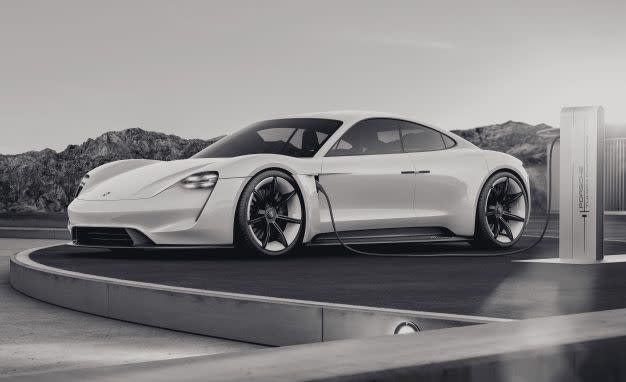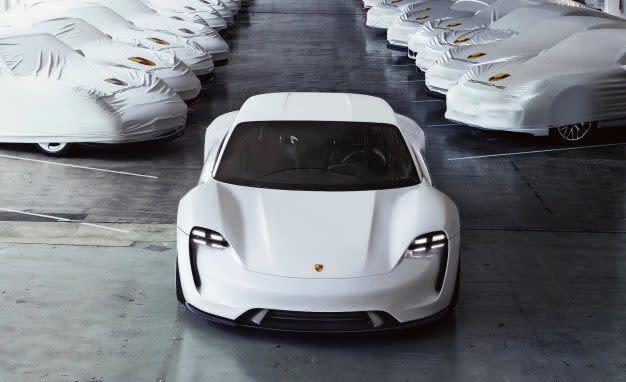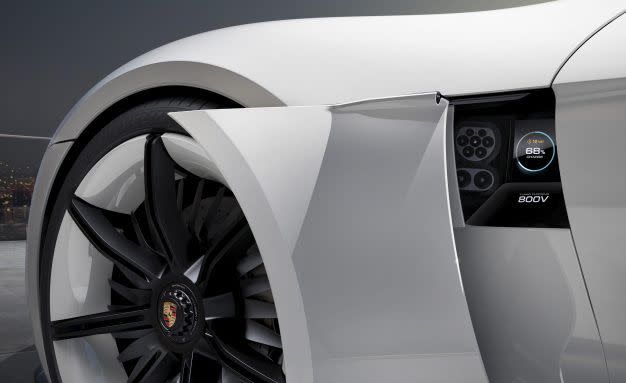Here’s Why the Porsche Mission E Charges into the Future with 800-Volt Technology


The Porsche Mission E will charge its battery pack, Porsche promises, in half the time it takes present-day Tesla vehicles, which are the charge-rate champions now. Porsche certainly plans to deliver on the strong and silent straight-line performance that has been Tesla’s longtime YouTube party trick—and to add the sustained hot-lap capability that comes with the Porsche pedigree and has been missing from Tesla. But when the test-drive gasps subside, it may be its charging performance that will set the Porsche Mission E apart when it arrives late next year.
That speedier charging, which Porsche is calling Turbo Charging—a shot over the bow at Tesla’s Supercharger tech and charging network—is made possible through a key decision made early in the development process. Engineers looked at the sort of charge times they wanted—with a long-term goal to restore a driving range of several hundred miles after only 10 to 15 minutes—and found 50-kW Level 3 speeds and even Tesla’s 120 kW to be unacceptable. With most electric cars’ underpinnings in the 400-volt range, Porsche’s goals simply wouldn’t be possible by the laws of physics. Porsche’s future EVs would be unreasonably limited at the charge port by the resistance (and heat) generated by raising the current high enough to reach the charging-power levels needed.
Eliminating the Bottleneck
The answer, to get the Mission E’s recharge time a lot closer to a traditional gas-station stop, is simple in theory: Double the voltage, and you can roughly double the power going into the battery pack while keeping the current the same—and without bulking up the hardware and adding weight.

“At the moment, on a 400-volt car, the charging connector is the bottleneck for the charging power,” said Joachim Kramer, Porsche’s director of power electronics for the Mission E and other electric-vehicle projects, summarizing the issues in an interview with C/D. As it turns out, that holds true all the way to the cell level. “Putting the cells in sequence—so, doubling the voltage—you could really get the full use of the battery cell and get a higher charge rate, because then the connector isn’t the limit.”
“
“The first guys have to take the development costs, and here they are not so low.”
– Joachim Kramer, Porsche
”
And that’s shaping up to be the Mission E’s ace card. Porsche doesn’t have (or need) any lock on special, game-changing battery-cell technology or a radically different chemistry to accomplish this. By using cells that are configured in parallel in 400-volt systems, but instead mounting them in series, Porsche has found an elegant solution that’s more than a workaround. Mounting them in sequence means you need double the voltage but half the current at the same input power. “Having the same cells as the 400-volt cars, we now operate at the battery limits,” Kramer asserted.
A Very Expensive Decision
Why haven’t others done this before? The answer is primarily cost. In order to make it work, the 800-volt transformation has to involve more than a charging system. While the cells can technically be the same, nearly everything else power related needs to be different—and the costs for all those pieces together are astronomical. For example, you need to wind e-motors to the specific voltage level and power level, said Kramer, admitting that the company was not aware of any 800-volt production vehicles in existence when it started the project.

Porsche developed its own motor, as well as its own inverters and onboard chargers, all with the same control philosophy as 400-volt units but with different power switches that can take 800 or 1000 volts. Some components were designed internally at Porsche and some with partner suppliers that had off-the-shelf components that wouldn’t do the job. “There was nothing in the market we could just buy and use” in the power electronics realm, Kramer said.
Potentially Cheaper in the Long Run
Volkswagen’s mainstream Modular Electrification Toolkit (MEB) platform for EVs is being developed for 400 volts. Yet here’s where the story behind the Mission E’s tech takes a surprise twist: Don’t be surprised if 800-volt systems trickle down from the luxury sector into the mainstream, perhaps as soon as the middle of the next decade. Kramer said he foresees costs dropping because of components that can be sourced from the wind-turbine and solar-energy-generation industries. “The first guys have to take the development costs, and here they are not so low,” he emphasized. “It needs a premium brand to do that and take the cost, but I’m pretty sure the 800-volt systems will carry through to the mass market—and in the long run I’m pretty convinced that this is the cheaper solution.”
Count Audi in for 800-volt tech in future vehicles, but it’s several years out—not in the upcoming 400-volt Audi e-tron and e-tron Quattro, but in the Mission E–based, Audi Sport–developed e-tron GT that will likely follow. Albrecht Reimold, the board member in charge of production, recently hinted that Porsche’s 800-volt motor would be available for purchase by other brands within the Volkswagen Group. “This is already the case with the V-8 engine,” he said in a company-published interview. “The only proviso is that we have the necessary production capacity.”
Don’t expect existing models to be retrofitted to 800 volts, though. Johan Peeters, vice president for marketing and sales at ABB, one of the leading producers of charging hardware, noted that there are some fundamental engineering differences in how you design components, or possibly where you place them. “It’s not rocket science, but you need better isolation and more distance between the contact points, for instance,” he said.

Porsche has been mindful about engineering in compliance with Combined Charging System (CCS) standards, so you’ll likely be able to charge a Mission E quite quickly with some of the hardware that’s being installed today, such as the many 150-kW chargers being deployed via Electrify America. At present, ABB’s fast chargers can accommodate up to 920 volts, so the capability is there. The 800-volt, 320-kW level that Porsche is using for its own Turbo Chargers helps it get under the 20-minute recharge target, like the 150-kW units, by using actively liquid-cooled cables. Porsche’s station layout saves space by using one large cooling reservoir for a bank of many chargers at a station—a move that’s still under debate, because some hardware makers think the chargers will be more reliable if they each draw from their own reservoir.
Efficiency Gains, Too
Going to 800 volts doesn’t just help pack the electrons into the battery pack more quickly. It actually yields better efficiency across the vehicle, Kramer said, because even when power demands are low you simply have a lower resistance in wiring, connectors, and all the current-leading components in the car—and that means lower losses (and potentially better reliability for the car itself). All the copper wires onboard will collectively have about a quarter of the losses—and heat—versus 400 volts, Kramer said, because of the lower current afforded. And it saves a lot of weight—up to 88 pounds over the entire vehicle—mainly in copper cables.
Porsche has nearly met its goal for charge time already. According to the automaker, the Mission E will be capable of regaining nearly 250 miles of range (out of its total of around 300) in just 15 minutes. Porsche is planning a network of Turbo Chargers, and Uwe Michael, the head of electrics and electronics development at the automaker, recently pointed to a Turbo Charging Planner that will reserve charging stations in advance along the way, aiming to give owners as little downtime as possible.
If there’s one potential hangup, it’s that the first buyers will need to have a little patience. There still probably won’t be a lot of places to charge a Mission E at full speed; nor will Porsche’s network of charging stations rival Tesla’s infrastructure by the time it goes on sale. But Porsche has gone above and beyond to make sure that there’s a lot of room for EV technology to grow.

You Might Also Like

 Yahoo Autos
Yahoo Autos 